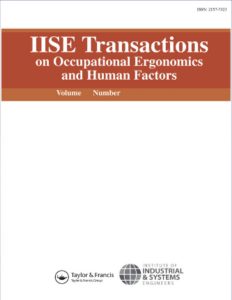Publications

Sternocleidomastoid muscle and head position: How to minimize muscle tension
Authors: Simona Rubine 1, Nadina Rimere 1, Zane Zundane 2, Alise Gulajeva 1, Jelena Reste 3
Affiliations:
- Faculty of Medicine, Riga Stradins University
- Faculty of Residency, Riga Stradins University
- Senior Researcher Institute of Occupational Safety and Environmental Health, Riga Stradins University
Journal: IISE Transactions on Occupational Ergonomics and Human Factors - October 2022 (DOI: 10.1080/24725838.2022.2141369)
-
Field & Applications:
- Medical
- Musculoskeletal health
- Balance / Postural control
Background: With the increasing demand for faster data processing, computers and other smart devices have become an integral part of many workplaces. The sternocleidomastoid (SCM) muscle is one of the main muscles supporting the head. A review of the available literature suggested that overuse of this muscle can provoke a number of complaints among employees, including head and neck pain. This article describes effective head positioning angles to minimize SCM muscle strain.
Purpose: The main objective of this study was to determine how SCM muscle tension changes with head position angle. We hypothesized that the SCM muscle would demonstrate the least tension when the head is in a neutral position.
Methods: A total of 41 individuals (22 female, 19 male) participated. Only respondents without chronic conditions were included. SCM muscle tension was measured using a myotonometer.
Results: Strong positive correlations were observed between angle (head position) and SCM muscle tension (oscillation frequency) as well as between angle and SCM muscle stiffness. Negative correlations were found between head angle and SCM decrement (a measure of elasticity), and between head angle and SCM relaxation time.
Conclusions: Minimal tension in SCM muscle occurs when the head is positioned in flexion, at angles between -30° and -60°. Determining the angle of minimal SCM tension provides a foundation for further research and various technical solutions that may ensure such positioning (e.g., a monitor arm). However, to obtain more accurate insight into optimal positioning, simultaneous evaluation of multiple neck muscles should be completed in future work, and the neck extensor muscle group must be addressed.
Keywords: ergonomics, monitor positioning, myotonometry, sternocleidomastoid muscle
In summary, we sought to determine the head position at which SCM tension is the lowest, and measurements were made with a myotonometer at different head placement angles (-0°, +30°, -30°, +60°, and -60°). We found that the lowest tension and stiffness of the SCM muscle were obtained at angles with neck flexion of -30° and -60°. No correlation was detected between the dominant arm of the study participants and SCM tension. To confirm or exclude the role of BMI, a study of people with increased or decreased BMI values is needed. However, in a functional setting, these results may likely be influenced by additional loads and muscle forces caused by the use of a keyboard or mouse, which, in turn, would lead to asymmetry and imbalance. Further research, including additional neck muscles, is needed to determine which head angle results in the lowest overall muscle tension.


